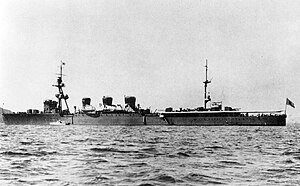Kuma-class cruiser

Kuma off Tsingtao, 1930
|
|
| Class overview | |
|---|---|
| Name: | Kuma class |
| Operators: |
|
| Preceded by: | Tenryū class |
| Succeeded by: | Nagara class |
| Built: | 1917–1921 |
| In commission: | 1920–1946 |
| Completed: | 5 |
| Lost: | 4 |
| General characteristics | |
| Type: | Light cruiser |
| Displacement: |
|
| Length: | |
| Beam: | 14.2 m (46 ft 7 in) |
| Draft: | 4.8 m (15 ft 9 in) |
| Propulsion: |
|
| Speed: | 36 knots (41 mph; 67 km/h) |
| Range: | 9,000 nmi (17,000 km) at 10 kn (12 mph; 19 km/h) |
| Complement: | 450 |
| Armament: |
|
| Armor: | |
The five Kuma-class cruisers (球磨型軽巡洋艦 Kuma-gata keijun'yōkan?) were light cruisers operated by the Imperial Japanese Navy (IJN). The Kuma-class cruisers proved useful in combat operations ranging from the Aleutian Islands to the Indian Ocean throughout World War II.
The Kuma-class was followed by the very similar Nagara class.
Despite the success of the Tenryū-class high speed light cruiser design, the Imperial Japanese Navy realized that they would be outgunned by the larger US Navy Omaha class of light cruisers then under development. In addition, the Tenryū-class vessels, with a maximum speed of 33 knots (61 km/h; 38 mph), were unable to keep up with the newer Japanese destroyers, such as the Minekaze class, which had a design speed of 39 knots (72 km/h; 45 mph). At the end of 1917, plans for an additional six Tenryū-class vessels, plus three new-design 7200 ton-class scout cruisers were shelved, in place of an intermediate 5,500 ton-class vessel which could be used as both a long-range, high speed reconnaissance ship, and also as a command vessel for destroyer or submarine flotillas.
With the development of the long range oxygen-propelled Type 93 "Long Lance" torpedoes in the 1930s, the Imperial Japanese Navy General Staff drafted plans to create a special "Night Battle Force" of torpedo cruisers. The idea was based on Japan's success in the naval Battle of Port Arthur in the Russo-Japanese War. As the new Type 93 torpedoes had a range longer than that of contemporary battleships' main battery, the concept was to have a high speed strike force attack an enemy fleet at night with a massive and overwhelming barrage of torpedoes. Major surface combatants would follow up at dawn to finish off the wounded enemy.
...
Wikipedia
